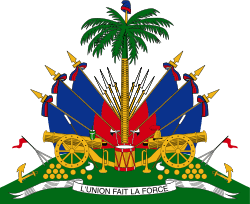Constitution of Haiti
The Constitution of Haiti (French: Constitution d'Haïti, Haitian Creole: Konstitisyon Ayiti) was modeled after the constitutions of the United States and France. The document was approved by Parliament in March 2011 and came into effect on June 20, 2012.
 |
|---|
| This article is part of a series on the politics and government of Haiti |
|
|
Legislature
|
|
Executive |
|
Judiciary |
|
Recent elections |
|
|
History

Constitution Monument in the Haitian capital Port-au-Prince
A total of 23 constitutions have been promulgated throughout Haiti's history,[1] the first of which was promulgated under the short-lived government of then-Governor-General Toussaint Louverture, who had become the leader of the revolutionary forces in the Haitian Revolution.
- Constitution of Saint-Domingue (1801). Established Toussaint as Governor for Life and gave him the right to select his successor (future governors would be limited to 5 year terms.) Provided a mechanism to overthrow any governor avoiding election. Abolished slavery and racial restrictions on employment, but upheld fermage, leases, and restrictions on movement. Estates abandoned by their owners during the revolution to be held and operated in trust by the government, but not nationalized. Banned free assembly, all religions other than Catholicism, divorce, and any imports in competition with local manufactures.
- Constitution of 1804
- Constitution of Hayti (1805). First constitution of Haiti proper. Created a non-hereditary empire under Dessalines. This constitution provided for freedom of religion, banned most whites from citizenship or owning land in Haiti, and declared all citizens "black" in an effort to end racism based on lightness of skin.
- Constitution of 1806, for the southern Republic of Haiti, written largely by Alexandre Pétion.
- Constitution of 1807 formalized a northern State of Haiti with Christophe as its President for Life and a small appointed Council of State, composed primarily of generals. Banned divorce and public exercise of any religion other than Catholicism, and suspended operation of the constitution at any location attended by the army. Unusual in its omission of any prohibition against white ownership of land.
- Constitution of 1811 for the northern State of Haiti, establishing a hereditary monarchy under Christophe. Again, prohibition against white ownership of land was omitted.
- Revision of the Haitian Constitution of 1806 (1816). Created a bicameral legislature of a House of Representatives ("composed of Three Members for the Capital of the Republic, of Two for the Capital of each Department, and of One Member for each Commune") and a Senate, established Pétion as President for Life, restricted the legislature to only consider bills proposed by the president, and provided for laws by presidential order, except for taxation. The Senate was no longer directly elected, but selected by the lower house from a list of nominees provided by the president. This constitution also provided automatic Haitian citizenship to any black, Indian, or person of mixed race who resided in the nation for more than a year.
- Constitution of 1843 under Charles Rivière-Hérard.
- Constitution of 1816 restored by Jean-Baptiste Riché.
- Constitution of 1846, under Jean-Baptiste Riché.
- Constitution of 1849. Re-established Haïti as an empire under Faustin I.
- Constitution of 1874 under Michel Domingue. Granted the executive had the power to dissolve the Chambers and to establish a Council of State to aid the Government. Power was given to the president for one year to change the judges and magistrates.
- Constitution of 1867
- Constitution of 1874
- Constitution of 1879
- Constitution of 1888
- Constitution of 1889
- Constitution of 1902
- Constitution of 1918, acclaimed by U.S.-backed plebiscite: 98,225 for, 769 against.
- Constitution of 1932
- Constitution of 1935. Anti-democratic. Allowed Sténio Vincent broad powers, including the ability to succeed himself.
- Constitution of 1932 reinstated (1942.)
- Constitution of 1946, Nov. 22. Constitution of Dumarsais Estime. Heinl, p. 552.
- Constitution of 1950.[2] Enfranchised women.
- Constitution of 1957.
- Constitution of 1964. Established François Duvalier as President for Life. Established a unicameral Legislature of 58 deputies.
- Constitution of 1983
- Constitution of 1987. Banned dual citizenship, effectively restricting Haitian-Americans (such as Samir Mourra and Dumarsais Simeus) from running for president in Haiti. Was ratified in March 1987, but it was completely suspended from June 1988 to March 1989 and was only fully reinstated in October 1994.
- Constitution of 2012. Currently in force. Re-legalizes dual citizenship, allows for Haitians living abroad to own land and run for Haitian political office (except for offices of president, prime minister, senator or member of the lower house of Parliament). Also demands the establishment of a permanent constitutional court to resolve disputes between Parliament and the executive, a new permanent electoral council to replace the provisional CEP, and that 30 percent of government jobs be held by women.
gollark: Hmm, graphs, those are always fun.
gollark: > <@!258639553357676545>> If you really want a good example, how about the JS you run when you access this site? How about the JS that is run when accessing other sites? A lot of them could use static or server side dynamically generated pages as opposed to JS.<@474726021652807680> A lot of time that's for development convenience as opposed to anything else. Or so it can actually respond in reasonable time to input and stuff.
gollark: DRM is inherently broken, it'll always run into this if people are dedicated enough.
gollark: https://en.wikipedia.org/wiki/AACS_encryption_key_controversy
gollark: Like the AACS master key thing a while ago.
See also
- Haitian constitutional referendums: 1918, 1928, 1935, 1939, 1964, 1971, 1985, 1987
References
- Belpolitik.com. "The Haitian Constitution Archived 2011-05-23 at the Wayback Machine." Accessed 9 Feb 2011.
- Heinl says (p. 564) that Dantès Bellegarde was the primary author.
External links
| Wikisource has original text related to this article: |
| Wikisource has original text related to this article: |
This article is issued from Wikipedia. The text is licensed under Creative Commons - Attribution - Sharealike. Additional terms may apply for the media files.
.svg.png)